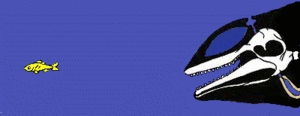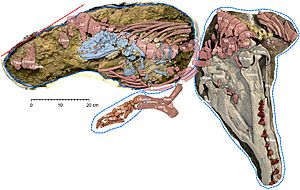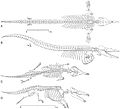Cetacea facts for kids
Quick facts for kids CetaceansTemporal range: early Eocene – Present
|
|
|---|---|
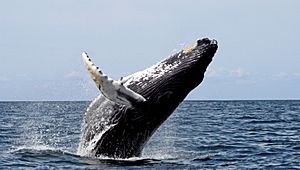 |
|
| humpback whale breaching | |
| Scientific classification | |
| Kingdom: | |
| Phylum: | |
| Class: | |
| Infraclass: | |
| Superorder: | |
| Order: |
Cetacea
|
| Suborders | |
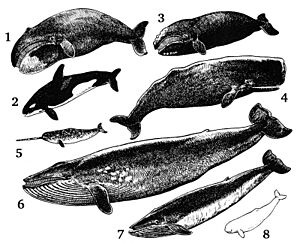
Cetaceans are amazing marine mammals that live in the ocean. This group includes all whales, dolphins, and porpoises. The word Cetus comes from Latin and means "whale" or "large sea animal." It comes from an old Greek word for "whale" or "sea monster." If you study cetaceans, you are studying Cetology.
Scientists believe that cetaceans evolved from land animals. These animals started living in the ocean about 50 million years ago. Today, cetaceans are the best adapted mammals for life in water. Their bodies are shaped like a torpedo, which helps them swim fast. Their front legs have changed into flippers. They have tiny back legs hidden inside their bodies. Their tails have flat, horizontal parts called flukes. Cetaceans have almost no hair. Instead, a thick layer of blubber keeps them warm in the cold ocean.
Some cetaceans are known for being very smart. Scientists have even discussed giving them special rights, like humans have. This shows how highly we think of their intelligence.
Contents
How do Cetaceans Breathe?
Cetaceans breathe air, just like humans. They must come to the surface of the water to breathe. When they surface, they breathe out carbon dioxide and breathe in fresh oxygen.
They have special openings called blowholes on top of their heads. These are like their nostrils. When a cetacean dives underwater, strong muscles close the blowholes. They stay closed until the animal comes back to the surface. Then, the muscles open the blowholes, and warm air shoots out.
Having blowholes on top of their heads makes breathing easier. They don't have to lift their whole head out of the water. When they breathe out, the warm air meets the cold air. This creates a cloud of "steam" or "spout." The shape and height of this spout can help people identify different whale species from far away.
Cetaceans can hold their breath for a very long time. This is much longer than most other mammals. Some can stay underwater for minutes, others for over an hour! They have special body features that help them do this. This allows them to hunt for food deep in the ocean.
How do Cetaceans See and Hear?
A cetacean's eyes are on the sides of its head. This means they can't see straight ahead very well. However, dolphins with pointed "beaks" can see forward and downward. Their eyes have special greasy tears that protect them from salty water. Their eye lenses are almost round. This helps them see in the dim light of deep water. Even though their vision might not be perfect, cetaceans have excellent hearing.
Echolocation: Seeing with Sound
Toothed whales, like dolphins and porpoises, use echolocation. This is like using sound to "see." They send out sounds and listen for the echoes that bounce back. This helps them figure out the size, shape, distance, and movement of objects.
Echolocation lets them find and catch fast-swimming prey in total darkness. It's so good that they can tell the difference between prey and other things, like humans or boats. Dolphins in captivity can even be trained to tell the difference between balls of different sizes!
Baleen whales have special ears that are very good at hearing low-frequency sounds. They use these sounds to communicate with each other.
Communication Through Sound
Cetaceans also use many different sounds to talk to each other. They make groans, moans, whistles, and clicks. Some, like the humpback whale, even sing complex "songs."
One type of dolphin, the tucuxi, can even sense prey using electroreception. This means they can detect tiny electrical signals given off by other animals.
What do Cetaceans Eat?
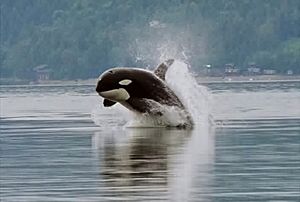
There are two main groups of cetaceans, and they eat in different ways.
Toothed Whales
Toothed whales, like the sperm whale, beluga, dolphins, and porpoises, have teeth. They use their teeth to catch fish, squid, or other sea creatures. They don't chew their food. Instead, they swallow their prey whole. If they catch large prey, like a seal, a killer whale might bite off pieces and swallow them one by one.
Baleen Whales
Baleen whales do not have teeth. Instead, they have special plates called baleen. These plates are made of keratin, which is the same material as your fingernails. Baleen hangs from their upper jaw. These plates act like a giant filter. They filter tiny animals, like krill and small fish, from the seawater. This group includes the blue whale, humpback whale, bowhead whale, and minke whale.
Not all baleen whales eat only tiny plankton. Larger species eat small schooling fish, like herring and sardines. The gray whale is a benthic feeder. This means it mostly eats crustaceans that live on the sea floor.
Types of Cetaceans
There are about 90 different species of cetaceans. Most of them live in the ocean. However, four species are freshwater dolphins that live in rivers.
The order Cetacea has two main groups:
- Mysticeti: These are the baleen whales.
- Odontoceti: These are the toothed whales, including dolphins and porpoises.
Cetaceans come in many sizes. The smallest is Commerson's dolphin, which is smaller than a human. The largest is the Blue Whale, which is the biggest animal known to have ever lived!
Cetaceans are mammals. Their closest living relatives are even-toed ungulates, like hippopotamuses and deer.
Mammals share some key features:
- They are warm-blooded.
- They breathe air using their lungs.
- They suckle their young with milk.
- They grow hair, though cetaceans have very little.
You can also tell a cetacean from a fish by looking at its tail. Fish tails are vertical and move side to side. Cetacean tails, called flukes, are horizontal. They move up and down, just like a human spine bends.
Images for kids
-
Skeletons of Dorudon atrox and Maiacetus inuus for comparison.
-
Dominoes made of baleen
-
Sea World show featuring bottlenose dolphins and false killer whales.
-
SeaWorld pilot whale with trainers.
See also
 In Spanish: Cetacea para niños
In Spanish: Cetacea para niños



